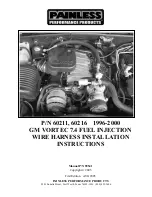
6-4
GETTING STARTED
ROAD SAFE GAS REGULATOR
Operating instructions
The use of upright gas cylinders from which
gas is
taken in the gas phase
is mandatory
for the operation of gas regulators, gas
equipment and gas systems. Gas cylinders
from which gas is taken in the liquid phase
(e.g. for fork lifts) must not be used, since
they would result in damage to the gas
system.
Taking into operation
Open gas remote switch if present.
1.
Open the cylinder’s valve.
2.
Firmly press the green reset button on
the high pressure hose.
3.
Press gas flow monitor reset button
(green button) on gas pressure regulator
slowly
.
4.
Release gas flow monitor reset button
(green button) on gas pressure regulator
slowly
(3 seconds). If no pressure point
is felt when the button is pressed again,
the regulator is ready for operation
(repeat procedure if necessary). Start
the gas-burning devices if desired. If the
gas cylinders are closed, SecuMotion
may switch off after an extended period
of no usage.
Changing a gas cylinder
Please use the included screwing tool to
attach and remove the high pressure hoses.
It will help you generate the necessary
tightening torque and will prevent damage to
the screw fittings, which may otherwise result
from using an improper tool.
When the cylinder is connected please
ensure that the high pressure hose is not
placed under any strain.
Residual gas: No smoking! No open
flames!
- Close the empty gas cylinder’s valve.
- Remove the high pressure hose from the
gas cylinder and remove the clip-on
adapter, if present.
- Attach the high pressure hose to the full
gas cylinder and apply the clip-on adapter,
if present.
- Open the full cylinder’s valve.
- Press the hose-break safety device and
the gas-flow monitor (see “Taking into
operation”).
Anytime after making changes, check the
hose connection to the cylinder valve for
leaks (see “Checking for leaks in the high
pressure area”).
Exchanging hoses.
Please use the included screwing tool to
attach and remove the high pressure hoses.
It will help you generate the necessary
tightening torque and will prevent damage to
the screw fittings, which may otherwise result
from using an improper tool.
Residual gas: No smoking! No open
flames!
- Close the gas cylinder’s valve.
- Remove the high pressure hose from the
gas cylinder (or from the slip-on adapter)
and from the regulator inlet.
When performing a hose change, please
ensure that the white gasket provided with
the hose (hose outlet - regulator inlet) is
correctly installed and not damaged.
We recommend that the gasket (part no.
50020-76300) be replaced with every hose
change.
- Screw country-specific high pressure hose
to SecuMotion inlet and cylinder (or to
adapter).
Open the gas cylinder’s valve.
- Press the hose-break safety device and, if
necessary, the gas-flow monitor (see
“Taking into operation”).
Anytime after making changes, check the
hose connections to the cylinder valve and to
the inlet of the SecuMotion gas-pressure
regulator for leaks.
Summary of Contents for Aspire
Page 5: ...1 2 INTRODUCTION ...
Page 11: ...4 2 MOTORWAY HANDLING ...
Page 13: ...5 2 ARRIVING ON SITE ...
Page 19: ...6 6 GETTING STARTED ...
Page 21: ...7 2 GAS SAFETY ADVICE ...
Page 59: ...9 36 HOW TO USE YOUR MOTORHOME S EQUIPMENT ...
Page 61: ...10 2 SECURITY Alarm Your Aspire motorhome is fitted with a category 1 alarm ...
Page 62: ...10 3 SECURITY ...
Page 63: ...10 4 SECURITY ...
Page 67: ...11 4 CARE OFYOUR MOTORHOME ...
Page 69: ...12 2 STORAGE ...
Page 73: ...13 4 WARRANTY ...
Page 75: ...14 2 MOTORHOME CONSTRUCTION ...
Page 77: ...15 2 EQUIPMENT LIST ...
Page 79: ...16 2 ELECTRICAL DRAWINGS ...
Page 85: ...18 4 GLOSSARY ...
Page 89: ...19 4 SERVICE DOCUMENTS ...
Page 91: ...20 2 CHANGE OF OWNERSHIP ...
Page 93: ...21 2 CHANGE OF ADDRESS ...
















































